AMS, or Advanced Mountaineering School, is always a challenge, but some years the field trips are tougher than others, just due to conditions. This is a mid-course description of my observations of the course based on descriptions from the students I encountered through my teaching of the Ice Clinic.
AMS consists of a sequence of field trips that covers the full range of winter high peak mountaineering, interspersed with lectures to help prepare for the field trips, covering all the topics that go into this demanding sport. It is considered the culmination of all of the outdoor courses taught by the Boulder Mountain Schools for those who aspire to the full mountaineering experience. Entrance to the course is by application the previous fall for consideration the following winter. The course and application process is described on the Boulder website.
I taught the Ice Clinic this year, consisting of a lecture at the Clubroom and a weekend field trip. This year there were enough students to divide the field trips into two groups going out each day that weekend. At the lecture, I was expected to discuss the basics of ice climbing, but this was preceded by a debriefing of the previous weekend’s field trip, which was the winter camping trip. The site that had been selected was at Left Hand Resevoir in the Indian Peaks. The approach is not difficult, a hike up a road for a couple of miles, but the location is purposefully exposed to conditions, necessitating the construction of snow shelters as a survival skill. As I listened to the students nonchalantly recount their experiences, I had to admire their strength and resilience. What they discovered, unfortunately, was that the snow at the site was very difficult to dig into there, which foiled attempts to construct an igloo, or even to build A-frame shelters. They did have some tents as backup shelters, but not enough for everyone. Consequently, several of them had to sleep in exposed conditions in high winds, basically in a trench in the snow, which would be tough for anyone. Everyone survived without risk of injury from exposure, though it sounded like it was difficult and uncomfortable experience, more for some than others.

Val Hovland, AMS Director, addressing the 2017 students & instructors, Feb 7, 2017 in the Clubroom
Fortunately, the Ice Clinic field trips do not require overnight camping!
I led the two weekend field trips for the Ice Clinic, on Saturday and Sunday, February 11th and 12th. The two days were quite a contrast, illustrating what extremes conditions in Colorado can swing between. On Saturday, I chose to stick with a site that AMS had used in the past, Silver Plume, due to its short approach and (normally) greater amount of ice to climb. I, as well as the other assistant instructors, were concerned about the unseasonably warm temperatures that the Front Range had been experiencing recently. The ice at Silver Plume is directly south facing, and in full sun most of the day. Arriving there early Saturday morning, I could see there was much less coverage on the approach, and was wondering with some dread what the actual ice climbing conditions would be like.
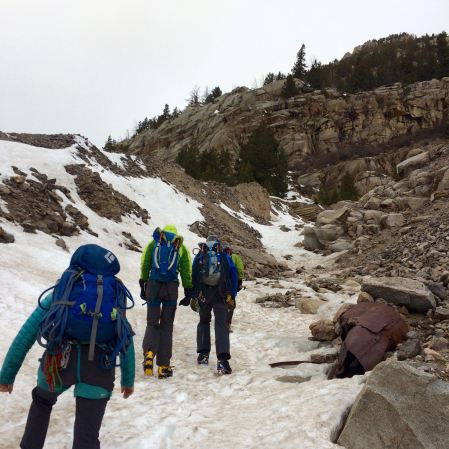
On the way up to the ice at Silver Plume, about 7:30am
What we saw when we got there was something akin to an ice climbing horror show:
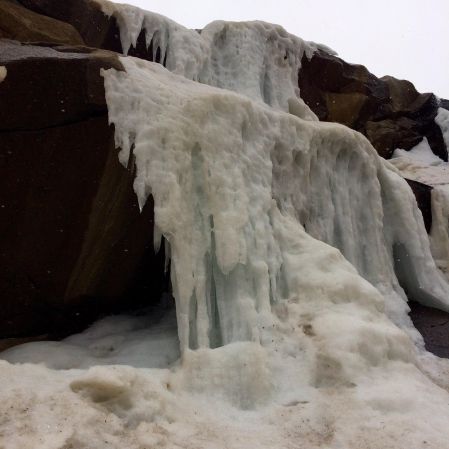
The main flow at Silver Plume, February 11, 2017: a fraction of its normal size in previous years
The main flow was only a shallow curtain of ice, and on the right side, where there were normally big pillars of ice, were flowing streams of water. Though seriously disappointed, I was determined to make the most of the situation, and not have the day be a total disappointment for the students. I asked my assistant instructor, Scott Edlin, to proceed with assisting the students to prepare for the other activities while I hiked up and around a side gully to set up a top rope anchor from above. There are bolts in rock above the ice, though I found that it would be necessary to place a directional ice screw to position the top rope above the one remaining ice flow. I attempted to do this, placing an ice screw into some ice of questionable integrity. As I began to rappel down, I found out just how questionable it was: it failed, and I unexpectedly twirled and pendulumed to the right, out of control. Fortunately, I had rigged an autoblock on my rappel device, which stopped me even though I lost control of the rope. Fazed but unhurt, I reassured the class that I was ok, and cursed the failed ice screw, now dangling from the rope in front of me.
One might have thought that this warning sign would have signaled a sign that ice conditions were not good enough to climb. But AMS instructor that I was, I was determined to provide my students a worthwhile experience, and placed another directional ice screw on rappel on the way down. Once at the base, I discussed a plan to place more ice protection on mock leads on the way up the flow, and hopefully reach the top. I asked what student would like to go first, and Jan Rous gallantly volunteered. A tough looking Czech, he had much rock experience, and some on ice. After I explained the plan, I stepped back to my pack to organize the gear for the exercise.
As I was fumbling around in my pack, I heard a loud, unexpected swooshing sound, and looked up to see the sky immediately above me full of slush and chunks of ice raining down. Expecting some major impact, I ducked in towards the snow, hunkering down to lessen my exposure. In a few seconds it was over, but the shock of the experience was not. No one else had been struck but me, but now clearly alarmed at the danger we were in, I loudly exclaimed to the class to pack up and get out of this danger zone. No one saw the avalanche as it happened, but it must have been some ice that was or near the top of the ice wall above me, since above that is a flat area.
Fortunately, nothing else came down as we all packed up our gear, and moved over to a gully on the right side. In this safe zone, the class was still able to practice using a mechanical ascender on a fixed line, one of the drills. Meanwhile, I hiked up to the anchor again to clean it, rap down and retrieve the rope. As we were hiking out, we saw some of the larger ice chunks that had come down, the largest the size of a big microwave. We were lucky that day. And I learned a lesson the hard way to not attempt to anything on ice that in such marginal condition.
The next day was blissfully uneventful and genuinely fun. We went to the East Portal of Moffat Tunnel, near Rollinsville, where the ice is quite shaded, faces northwest and sees almost no sun. It is a smaller area, but it was enough to share between our group and another climbing party. Here we were able to conduct all the drills for the Ice Clinic: climbing on top rope, mock leading on top rope (optional), placing and retrieving ice screws, making V thread anchors, and ascending and descending a fixed line with a mechanical ascender.
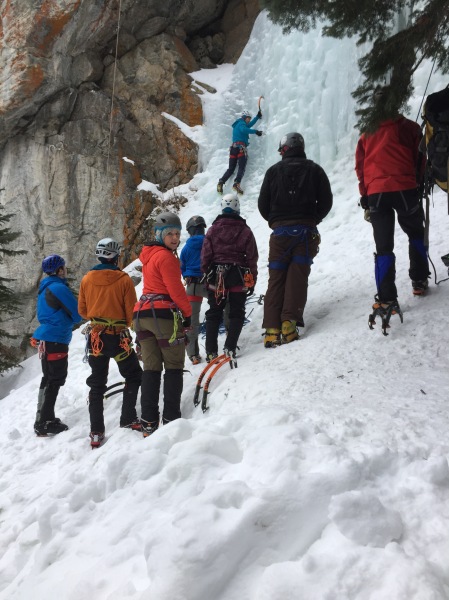
Rob Dunkel, assistant instructor, starts up leading the ice pitch. Kahle Toothill turned around as I took the photo.
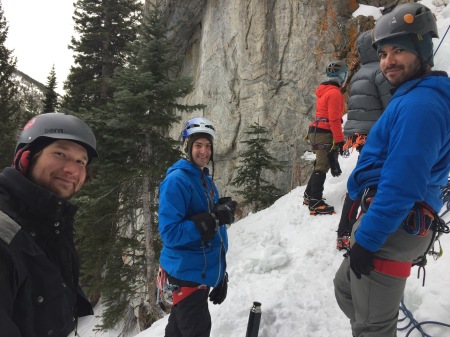
Daniil Gladkov, Chris Marchbanks and Ben Feinstein enjoying the start of the clinic.

Jordan Holquist intently belaying a climber above, and Scott Edlin shows Kahle Toothill about ice screws in the background.

Jennifer Buechler practices descending a fixed line with a Petzl ascender…which is trickier than it looks!
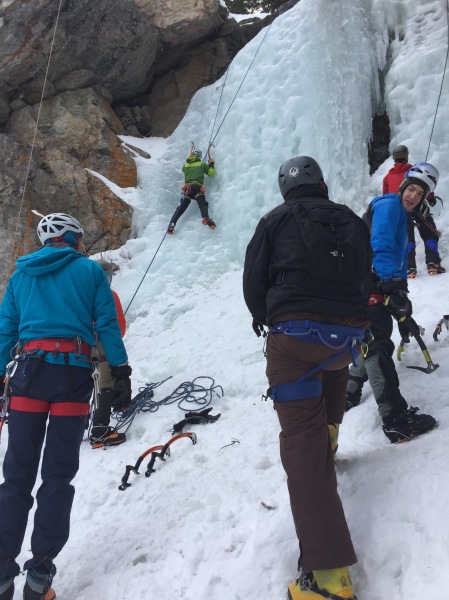
Jordan Holdquist takes a lap, as Rob, Daniil and Chris observe. (A second, non-CMC group is climbing on the right.)

Chris Marchbanks puts full body weight on his V thread anchor, as instructor Scott Edlin looks on
Next weekend will be the last exercise for the AMS students, climbing a Fourteener in winter with a required overnight campsite. I wish them all a safe and successful trip!
Leave a comment